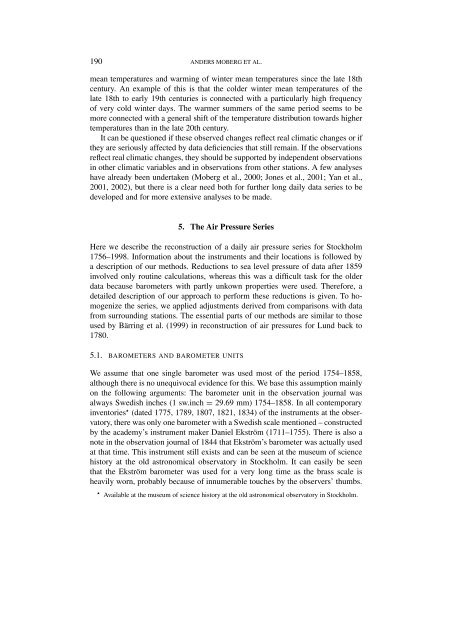DAILY AIR TEMPERATURE AND PRESSURE SERIES ... - BALTEX
DAILY AIR TEMPERATURE AND PRESSURE SERIES ... - BALTEX
DAILY AIR TEMPERATURE AND PRESSURE SERIES ... - BALTEX
You also want an ePaper? Increase the reach of your titles
YUMPU automatically turns print PDFs into web optimized ePapers that Google loves.
190 <strong>AND</strong>ERS MOBERG ET AL.<br />
mean temperatures and warming of winter mean temperatures since the late 18th<br />
century. An example of this is that the colder winter mean temperatures of the<br />
late 18th to early 19th centuries is connected with a particularly high frequency<br />
of very cold winter days. The warmer summers of the same period seems to be<br />
more connected with a general shift of the temperature distribution towards higher<br />
temperatures than in the late 20th century.<br />
It can be questioned if these observed changes reflect real climatic changes or if<br />
they are seriously affected by data deficiencies that still remain. If the observations<br />
reflect real climatic changes, they should be supported by independent observations<br />
in other climatic variables and in observations from other stations. A few analyses<br />
have already been undertaken (Moberg et al., 2000; Jones et al., 2001; Yan et al.,<br />
2001, 2002), but there is a clear need both for further long daily data series to be<br />
developed and for more extensive analyses to be made.<br />
5. The Air Pressure Series<br />
Here we describe the reconstruction of a daily air pressure series for Stockholm<br />
1756–1998. Information about the instruments and their locations is followed by<br />
a description of our methods. Reductions to sea level pressure of data after 1859<br />
involved only routine calculations, whereas this was a difficult task for the older<br />
data because barometers with partly unkown properties were used. Therefore, a<br />
detailed description of our approach to perform these reductions is given. To homogenize<br />
the series, we applied adjustments derived from comparisons with data<br />
from surrounding stations. The essential parts of our methods are similar to those<br />
used by Bärring et al. (1999) in reconstruction of air pressures for Lund back to<br />
1780.<br />
5.1. BAROMETERS <strong>AND</strong> BAROMETER UNITS<br />
We assume that one single barometer was used most of the period 1754–1858,<br />
although there is no unequivocal evidence for this. We base this assumption mainly<br />
on the following arguments: The barometer unit in the observation journal was<br />
always Swedish inches (1 sw.inch = 29.69 mm) 1754–1858. In all contemporary<br />
inventories ⋆ (dated 1775, 1789, 1807, 1821, 1834) of the instruments at the observatory,<br />
there was only one barometer with a Swedish scale mentioned – constructed<br />
by the academy’s instrument maker Daniel Ekström (1711–1755). There is also a<br />
note in the observation journal of 1844 that Ekström’s barometer was actually used<br />
at that time. This instrument still exists and can be seen at the museum of science<br />
history at the old astronomical observatory in Stockholm. It can easily be seen<br />
that the Ekström barometer was used for a very long time as the brass scale is<br />
heavily worn, probably because of innumerable touches by the observers’ thumbs.<br />
⋆ Available at the museum of science history at the old astronomical observatory in Stockholm.













